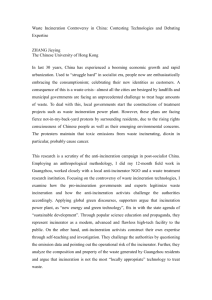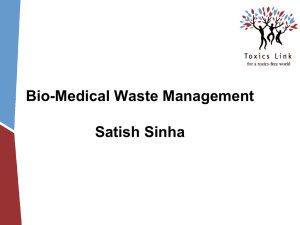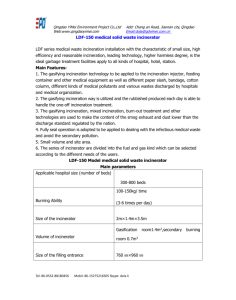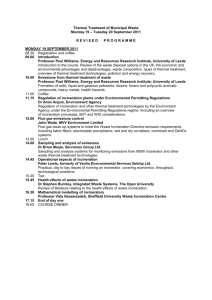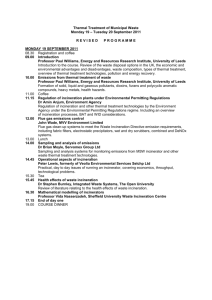Comments
advertisement
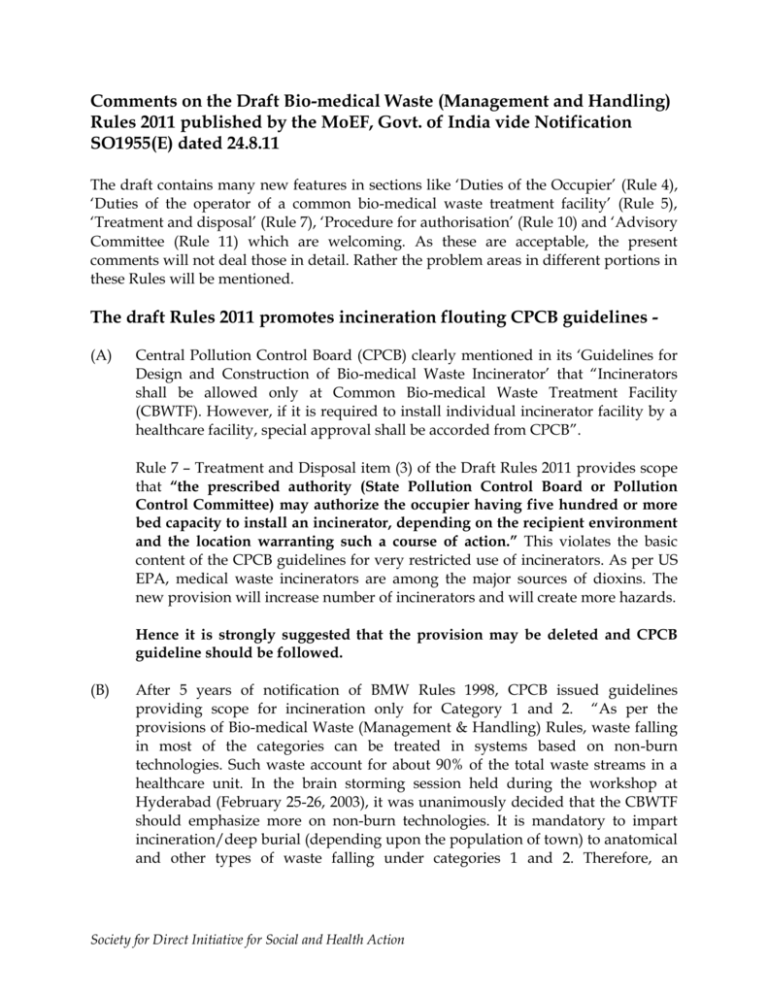
Comments on the Draft Bio-medical Waste (Management and Handling) Rules 2011 published by the MoEF, Govt. of India vide Notification SO1955(E) dated 24.8.11 The draft contains many new features in sections like ‘Duties of the Occupier’ (Rule 4), ‘Duties of the operator of a common bio-medical waste treatment facility’ (Rule 5), ‘Treatment and disposal’ (Rule 7), ‘Procedure for authorisation’ (Rule 10) and ‘Advisory Committee (Rule 11) which are welcoming. As these are acceptable, the present comments will not deal those in detail. Rather the problem areas in different portions in these Rules will be mentioned. The draft Rules 2011 promotes incineration flouting CPCB guidelines (A) Central Pollution Control Board (CPCB) clearly mentioned in its ‘Guidelines for Design and Construction of Bio-medical Waste Incinerator’ that “Incinerators shall be allowed only at Common Bio-medical Waste Treatment Facility (CBWTF). However, if it is required to install individual incinerator facility by a healthcare facility, special approval shall be accorded from CPCB”. Rule 7 – Treatment and Disposal item (3) of the Draft Rules 2011 provides scope that “the prescribed authority (State Pollution Control Board or Pollution Control Committee) may authorize the occupier having five hundred or more bed capacity to install an incinerator, depending on the recipient environment and the location warranting such a course of action.” This violates the basic content of the CPCB guidelines for very restricted use of incinerators. As per US EPA, medical waste incinerators are among the major sources of dioxins. The new provision will increase number of incinerators and will create more hazards. Hence it is strongly suggested that the provision may be deleted and CPCB guideline should be followed. (B) After 5 years of notification of BMW Rules 1998, CPCB issued guidelines providing scope for incineration only for Category 1 and 2. “As per the provisions of Bio-medical Waste (Management & Handling) Rules, waste falling in most of the categories can be treated in systems based on non-burn technologies. Such waste account for about 90% of the total waste streams in a healthcare unit. In the brain storming session held during the workshop at Hyderabad (February 25-26, 2003), it was unanimously decided that the CBWTF should emphasize more on non-burn technologies. It is mandatory to impart incineration/deep burial (depending upon the population of town) to anatomical and other types of waste falling under categories 1 and 2. Therefore, an Society for Direct Initiative for Social and Health Action incinerator of adequate capacity to cater only categories 1 and 2 waste shall be installed.” But the Draft Rules 2011 in its Schedule I provides “Incineration” as only option for Category 6 which is a bulk portion of bio-medical waste. This is a clear violation of CPCB guidelines. It is suggested that “Autoclaving or Microwaving” should be provided option for treatment of Category 6 instead of “Incineration”. Relevant change should be made also in Schedule II replacing Category 6 from Yellow bag to Red bag. (C) Even for Category 1 and 2, earlier Rules (1998) provided scope both for incineration and deep burial. The Draft Rules 2011 in the name of removing confusion gives only one option for each category and specifies “Incineration” as only option for Category 1 and 2 (in specified column of Schedule I). In the foot note it is mentioned that deep burial is prohibited in Towns and Cities. But there are many towns and cities in India which are still not within reach of CTF. Regular plying of CTF vehicles may not be cost effective there. In some cases, in hilly areas, forests and delta regions like Sundarbans, there are small towns which may not be covered by CTF in near future. Is it suggested that so long the health care units of these areas are not covered by any CTF, they should do nothing to manage their BMW? Or should they openly burn in the name of incineration as deep burial is prohibited? Again in case of rural areas it is added that “deep burial is permitted only in rural areas where there is no access to common bio-medical waste treatment facility, with prior approval from the prescribed authority” (italics ours). As such any health care unit, as per Rules, needs approval of prescribed BMW management authority. Then what is the significance of mentioning this? Does it mean that if Cat 1, 2 and 6 are burnt (obviously one has to burn because prescribed incinerators cannot be available in remote rural areas) prior approval is not required? Is prior approval required only for deep burial? Considering the issues discussed above, the option of “deep burial” (with conditions) should be inserted along with “Incineration” in the specified column of Schedule I – Cat 1 and 2. (D) The Draft Rules 2011 directs to dispose of Incineration Ash through secured landfill, “if toxic or hazardous constituents are present beyond the prescribed limits……” It is not mentioned clearly that if toxic or hazardous constituents are not present, where it should be disposed of. Whether it would be possible to change the address of disposal depending upon presence of toxicity and hazard in the incineration ash at any point of time? Society for Direct Initiative for Social and Health Action There should be a clear direction about this in the Rules. Also replacing of “secured landfill” by “hazardous waste landfill” may be considered. (E) Colour codings – Single colour has been suggested for each category contrary to the earlier system where flexibility was allowed and health care units could decide in the given premise to opt a colour according to the disposal option of the specific category. For example, if Cat 1 and 2 are to be sent in deep burial and Cat 6 for sterilization, different colours will be needed for them. But the draft Rules prohibit such flexibility. At present, in most cases in India, Cat 7 (which is a major portion of BMW) is sorted in blue bag both for CTF and for local treatment. Changing the system in large number of health care units may create confusion among the health workers. The issue needs to be dealt considering the ground reality. Issue of Reducing Number of Categories In BMW Rules bio-medical waste were divided into 10 categories. The Draft Rules 2011 in its Schedule I, reduced the number of categories to 8. But again it mentioned both “Liquid Waste” and “Incineration Ash” in the foot note of Schedule I. Standard of Liquid Waste before discharge has also been mentioned in Schedule V Item 3. Then what is the significance of reduction of the number of categories? It is suggested to keep the number of categories of BMW intact as they were. Segregation of Municipal Waste in Health Care Facilities The Draft Rules 2011 prescribes colour coding for municipal (non-bio-medical) waste as “Black”. While welcoming the move of specifying colour coding of bags for municipal waste it is pertinent to mention that the Municipal Solid (Waste and Management) Rules 2000 promotes segregation of dry (recyclable) and compostable (wet) waste at source. Specifying only one colour for all kinds of municipal waste will violate the principle. It is suggested that scope for segregation of municipal waste at source may be provided. Society for Direct Initiative for Social and Health Action
